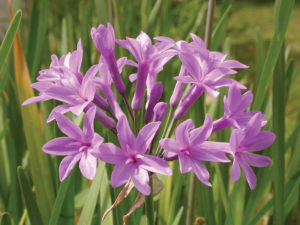
Name: Tulbaghia violacea Harv.
Family: Alliaceae (Onion family)
Common names: Engl. Wild Garlic; Afr. Wilde Knoffel; Xho. Itswele lomlambo
Description
Bulbous geophyte, 20-35 cm tall with strongly aromatic smell. Basal leaves blue-grey, sub-erect, linear and glaucous. The mauve-purple flowers are unmistakable and have only three small lobes at the entrance to the flower tube. All parts of the plant smell strongly of garlic when bruised, and it is often planted by gardeners as protection from moles. Plants flower from November to April.
Conservation status
According to the SANBI (South African National Biodiversity Institute) Red list of South African Plants, Tulbaghia violacea was not selected in any one of four screening processes for highlighting potential taxa of conservation concern for detailed assessment and was hence given an automated status of Least Concern (L.C.). http://redlist.sanbi.org
Distribution and habitat. It’s usually found in forest margins and stream banks. Provincial distribution: Eastern Cape, KwaZulu-Natal, and Western Cape.
Derivation of name and historical aspects
Tulbaghia named in honour of Ryk Tulbagh (14 May 1699-11 August 1771) who was the governor of the Dutch Cape Colony from 27 February 1751 to 11 August 1771 under the Dutch East Indian Company (VOC). Violacea means violet-coloured. Itswele lomlambo derives from itswele, meaning onion, and umlambo meaning river.
This plant bloomed in Baron von Ludwig’s garden at the Cape of Good Hope and was illustrated and described by Harvey. As early as 1772, the Swedish botanist Carl Thunberg reported the use of Tulbaghia roots as charm to repel “serpents” by the Khoekhoen in the vicinity of Tulbagh.
Unlike many other geophytes, tulbaghias do not require fire to stimulate flowering, but they need good rain to flower well. T. violacea seems likely to be pollinated by butterflies and bees. Ecology
Uses and cultural aspects
Bulbs and leaves are used.
Wild garlic is traditionally used for fever and colds, but also for asthma and enemas for stomach problems. The leaves are used to treat cancer of the oesophagus. Another species, T. alliacea, was an early Cape remedy for fever and is also used as a purgative and for fits, rheumatism and paralysis. T. simmleri is often used as a substitute for T. violacea. The fleshy harvested bulbs are boiled and the decoctions either taken orally or as an enema. The leaves may be eaten as vegetables.
An infusion of the whole plant is sprinkled (ukutshiza) around the home, particularly outside doors and windows and at the entrance to the byre, as a protection from evil spirits. Live plants are grown around the home as protection from evil spirits and witchcraft, particularly umamlambo “the snake familiar”. The tuberous root is chewed to treat anxiety attacks (umbilini) caused by witchcraft.
Growing Tulbaghia violacea
This plant is a great choice for the gardeners as it tolerates full sun, hot conditions and most soil types. Of course, it does even better with regular watering, but this is not essential. It makes for pretty groundcover, edging to a bed, or the flanking of pathways. Although it is fine in full sun, it can also flourish in semi-shade conditions, making it versatile and adaptable. Soil with a good drainage system and plenty of compost is ideal, and gardeners can prolong the lifespan and encourage a healthy, flourishing plant by understanding these simple steps.
Propagation
The Tulbaghia violacea can be propagated by seed, which should be sown in the spring (September to November) for best results. They should first be planted in deep trays, then replanted into the garden in their second year. They can also be grown by dividing the clumps. Once these have been planted leave them for as long as possible without moving or otherwise disturbing them. Gardeners can expect the first flowers to appear two or three years after planting.
- Someleze Mgcuwa is a plant digitiser at the Schonland Herbarium at the Albany Museum. Read his monthly column, Traditions to Treasure, here:
http://www.grocotts.co.za/2018/01/29/local-and-lovely-needs-a-headline/


